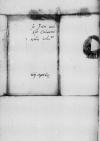List #1694
Bona Sforza do Ioannes DANTISCUSSzydłów, 1537-08-27
| odebrano [1537]-09-04 Rękopiśmienne podstawy źródłowe:
| ||||
Tekst + aparat krytyczny + komentarzZwykły tekstTekst + komentarzTekst + aparat krytyczny
Reverendo in paper damaged⌈[Reverendo in]Reverendo in paper damaged⌉ Christo patri, domino Ioanni Dantisco paper damaged⌈[
Reverende in Christo Pater, nobis sincere dilecte.
Accepimus litteras Paternitatis Tuae, illis quoque inclusas has
, quas il paper damaged⌈[l]l paper damaged⌉lustris
Venerabilem
Quae bene valeat.
Dat(ae) or Dat(um)⌈Dat(ae)Dat(ae) or Dat(um)⌉ in
Ad mandatum proprium sacrae maiestatis reginalis


 BCz, 3465, p. 266
BCz, 3465, p. 266